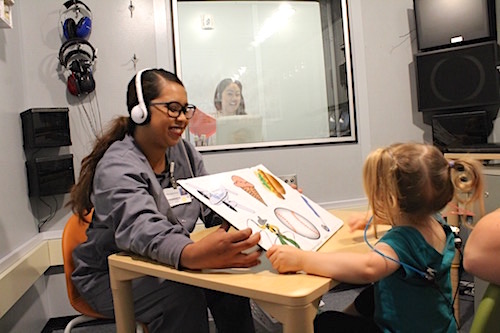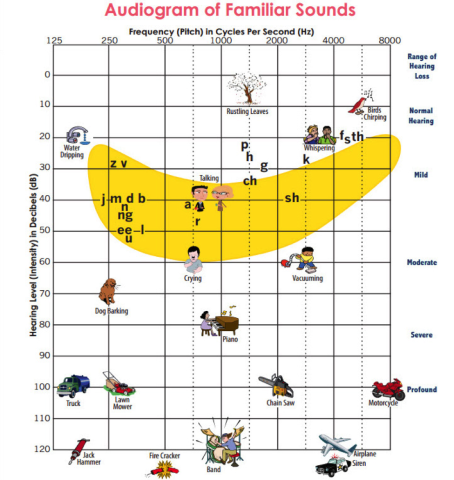Pediatric

Hearing and Speech

Speech Banana Audiogram
The audiogram graph below is a tool that can be used to understand sounds we can hear (or can’t hear) based on hearing thresholds. Common sounds are plotted on the graph to indicate their average pitch and volume. Louder sounds (e.g. are toward the bottom of the graph, softer sounds are toward the top. Low pitched sounds are on the left, higher pitched sounds are on the right.
Hearing test results can be transferred onto this graph to show which sounds are inaudible (above/softer than the hearing thresholds) and audible (below/louder than the hearing thresholds). For example, if an individual’s threshold of hearing was determined to be 60 dB HL at 250 Hz, the graph suggests that this individual would hear a dog barking but average volumes of the “j,” “m,” etc. sounds cannot be heard.
“Speech banana” is a term used to describe the area where most sounds of average conversational speech occur on this graph. Because the area resembles the shape of a banana, professionals refer to these plotted speech sounds as the speech banana. While many other sounds fall outside of the speech banana, audiologists are most concerned with the frequencies within the speech banana because a hearing loss in those frequencies can affect a child's ability to learn language.
In children, it is particularly important to consider the different sounds of speech. A child that can hear the speech sounds will have an easier time imitating, understanding, and learning spoken language when compared to a child who cannot hear all the speech sounds.
Ages and Stages
Birth to 3 months
- Quiets to familiar sounds or voices
- Reacts/startles to loud sounds
- Makes cooing noises
3 to 6 months
- Attempts to localize sounds with head or eyes
- Starts to make simple speech sounds
6 to 9 months
- Responds to “no” and own name
- Babbles
9 to 12 months
- Imitates speech sounds
- Turns head to soft sounds
- Understands simple words like “mom,” “milk,” “ball”
- First words emerge
12 to 18 months
- Follows simple directions, like “get the ball”
- Points to people or objects when asked
- Continues to learn new words
- Uses 10 or more words
18 to 24 months
- Uses 20 or more words
- Combines words into short phrases
- Listens to simple stories or songs
2 years to 3 years
- Uses 2-3 word sentences
- At 2 years, people can understand what the child says 25-50% of the time
- At 3 years, people can understand what the child says 50-75% of the time
- Follows multiple step directions
3 years to 4 years
- Processes complex sentences
- Can retell stories with detail (e.g. 5 sentences)
